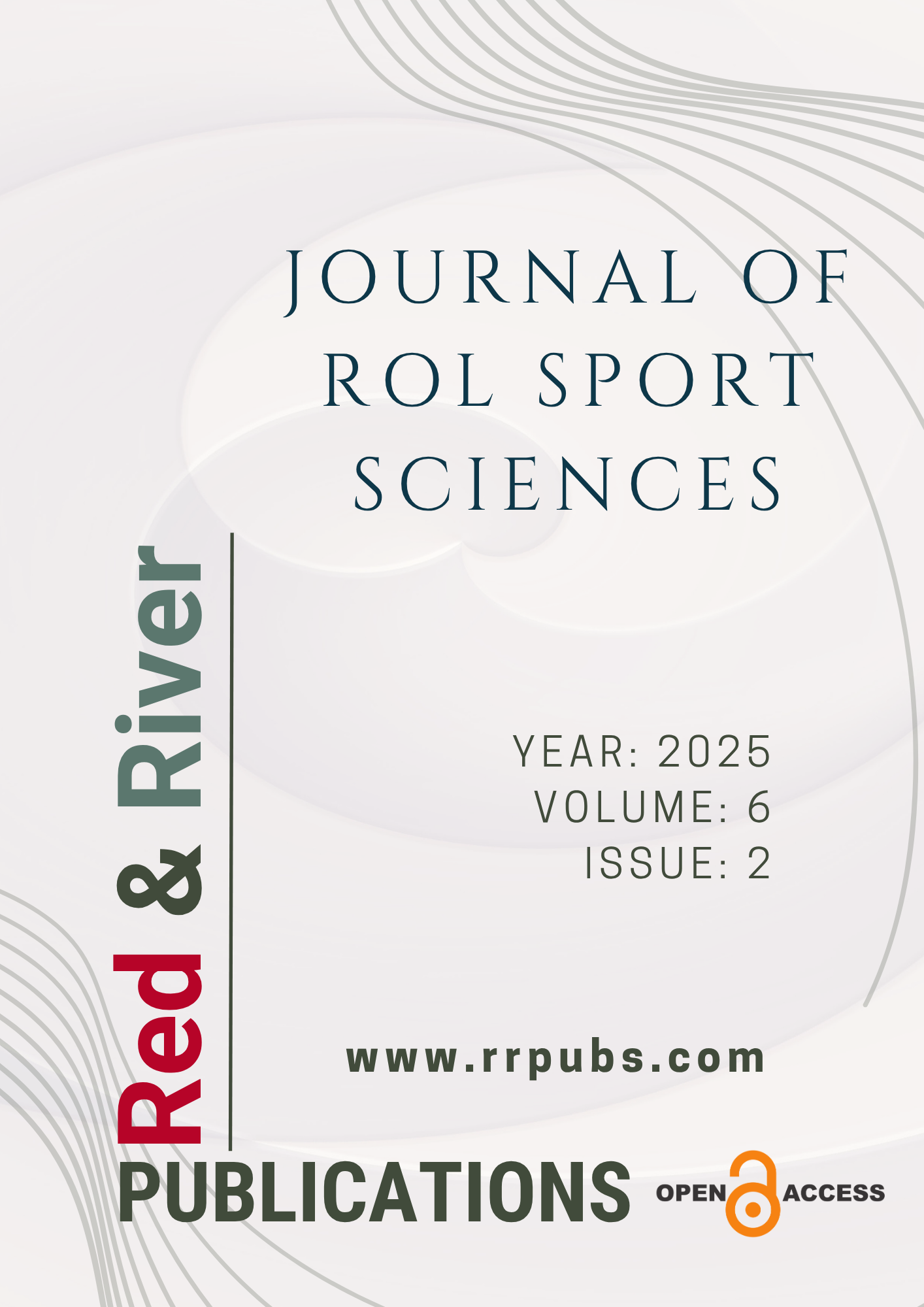The effect of intensive fencing training on attention levels of fencing athletes
DOI:
https://doi.org/10.70736/jrolss.539Keywords:
attention, fencing, trainingAbstract
This study examined the effect of intensive fencing training on the attention levels of fencing athletes. 32 fencing athletes aged 12-14 who had participated in fencing competitions for at least 2 years participated in the study. The participants were administered the d2 attention test. Pre-tests were administered before the start of a 1-week intensive fencing training program, and post-tests were administered after the end of the training program. Normally distributed data were analyzed using the Dependent Samples t-Test, and non-normally distributed data were analyzed using the Wilcoxon Signed Rank Test. In line with the data obtained, it was determined that the attention levels of fencing athletes aged 12-14 years increased significantly with short-term intensive fencing training. The study should shed light on future research that contributes to the literature.
References
Arslan-Kabasakal, S. (2024). Physical education lessons improve physical fitness and functional mobility in rural children with limited participation in regular physical activities: comparison of integrated neuromuscular training and core stabilization training. Biomedical Human Kinetics, 16(1), 285-294. https://doi.org/10.2478/bhk-2024-0030 DOI: https://doi.org/10.2478/bhk-2024-0030
Arslan Kabasakal, S., Gökşin, Ş.Ö., Keskin, B., & Güvendi, B. (2024). Does basketball training increase balance scores in children?. Pedagogy of Physical Culture and Sports, 28(1), 63-71. https://doi.org/10.15561/26649837.2024.0107 DOI: https://doi.org/10.15561/26649837.2024.0107
Asan, R. (2011). Sekiz haftalık masa tenisi egzersizinin 9-13 yaş arası çocuklarda dikkat üzerine etkisi. [Yüksek lisans tezi, Selçuk Üniversitesi].
Atakurt, E., Şahan, A., & Erman, K. A. (2017). Oryantiring eğitiminin dikkat ve bellek üzerine etkisinin incelenmesi. SPORMETRE Beden Eğitimi ve Spor Bilimleri Dergisi, 15(4), 127-134. https://doi.org/10.1501/Sporm_0000000327 DOI: https://doi.org/10.1501/Sporm_0000000327
Avanoğlu, A. E., Karakaya, F., & Hazar, S. (2020). Fiziksel aktivite düzeyi ile dikkat seviyesi arasındaki ilişkinin incelenmesi. Sivas Cumhuriyet Üniversitesi Spor Bilimleri Dergisi, 1(1), 10-16
Barth, B., Janka, C., & Beck, E. (2017). The complete guide to fencing. Meyer & Meyer Sport.
Bates, M. E., & Lemay, E. P. (2004). The d2 Test of attention: construct validity and extensions in scoring techniques. Journal of the International Neuropsychological Society, 10(3), 392-400. DOI: https://doi.org/10.1017/S135561770410307X
Brickenkamp, R. (1962). Aufmerksamkeits-Belastungs-Test (Test d2). [The d2 Test of attention.] (1st ed.). Hogrefe.
Brickenkamp, R., & Zillmer, E. (1998). The d2 test of attention. Hogrefe & Huber. DOI: https://doi.org/10.1037/t03299-000
Cohen, J. (1988). Statistical power analysis for the behavioral sciences (2nd ed.). Hillsdale, NJ: Lawrence Erlbaum Associates.
Creswell, J. W. (2014). Research design: Qualitative, quantitative and mixed methods approaches (4th edition). SAGE Publications.
Çağlar, E., & Koruç, Z. (2006). D2 dikkat testinin sporcularda güvenirliği ve geçerliği. Spor Bilimleri Dergisi, 17(2), 58-80.
Eysenck, M. W., & Keane, M. T. (2020). Cognitive psychology: A student’s handbook. Psychology Press. https://doi.org/10.4324/9781351058513 DOI: https://doi.org/10.4324/9781351058513
Fontani, G., Lodi, L., Felici, A., Migliorini, S., & Corradeschi, F. (2006). Attention in athletes of high and low experience engaged in different open skill sports. Perceptual and Motor Skills, 102(3), 791-805. https://doi.org/10.2466/pms.102.3.791-805 DOI: https://doi.org/10.2466/pms.102.3.791-805
Gazzaniga, M. S., Ivry, R. B., & Mangun, G. R. (2018). Cognitive neuroscience: The biology of the mind. W. W. Norton.
George, D., & Mallery, P. (2018). IBM SPSS statistics 25 step by step: A simple guide and reference. Routledge. https://doi.org/10.4324/9781351033909 DOI: https://doi.org/10.4324/9781351033909
Göktepe, M., Akalın, T. C., & Göktepe, M. M. (2016). An analysis of attention levels of children ınvolved in the sport of skiing. International Journal of Sport Culture and Science, 4(Special Issue 3), 722-731. DOI: https://doi.org/10.14486/IntJSCS620
Hijazi, M. M. K. (2013). Attention, visual perception and their relationship to sport performance in fencing. Journal of Human Kinetics, 39, 195-201. https://doi.org/10.2478/hukin-2013-0082 DOI: https://doi.org/10.2478/hukin-2013-0082
Kartal, R., Dereceli, Ç., & Kartal, A. (2016). Eskrim sporu yapan ve yapmayan 10-12 yaş arası çocukların dikkat düzeylerinin incelenmesi. Sportif Bakış: Spor ve Eğitim Bilimleri Dergisi, 3(2), 82-88.
Laursen, P. B. (2010). Training for intense exercise performance: High-intensity or high-volume training? Scandinavian Journal of Medicine & Science in Sports, 20 (Suppl. 2), 1-10. https://doi.org/10.1111/j.1600-0838.2010.01184.x DOI: https://doi.org/10.1111/j.1600-0838.2010.01184.x
Majorek, M., Tüchelmann, T., & Heusser, P. (2004). Therapeutic Eurythmy—movement therapy for children with attention deficit hyperactivity disorder (ADHD): A pilot study. Complementary Therapies in Nursing and Midwifery, 10(1), 46-53. https://doi.org/10.1016/S1353-6117(03)00087-8 DOI: https://doi.org/10.1016/S1353-6117(03)00087-8
Mardon, N., Richards, H., & Martindale, A. (2016). The effect of mindfulness training on attention and performance in national-level swimmers: An exploratory ınvestigation. The Sport Psychologist, 30(2), 131-140. https://doi.org/10.1123/tsp.2014-0085 DOI: https://doi.org/10.1123/tsp.2014-0085
Memmert, D., & Furley, P. (2007). “I spy with my little eye!”: Breadth of attention, inattentional blindness, and tactical decision making in team sports. Journal of Sport & Exercise Psychology, 29(3), 365-381. DOI: https://doi.org/10.1123/jsep.29.3.365
Mujika, I., Halson, S., Burke, L. M., Balagué, G., & Farrow, D. (2018). An ıntegrated, multifactorial approach to periodization for optimal performance in ındividual and team sports. International Journal of Sports Physiology and Performance, 13(5), 538-561. https://doi.org/10.1123/ijspp.2018-0093 DOI: https://doi.org/10.1123/ijspp.2018-0093
Orhan, S. (2018). Oyun eğitiminin sedanter çocukların dikkat ve konsantrasyon düzeyi ile el-göz koordinasyonuna etkisi [Yüksek lisans tezi, Fırat Üniversitesi].
Petersen, S. E., & Posner, M. I. (2012). The attention system of the human brain: 20 years after. Annual Review of Neuroscience, 35, 73-89. https://doi.org/10.1146/annurev-neuro-062111-150525 DOI: https://doi.org/10.1146/annurev-neuro-062111-150525
Roi, G. S., & Bianchedi, D. (2008). The science of fencing. Sports Medicine, 38(6), 465-481. https://doi.org/10.2165/00007256-200838060-00003 DOI: https://doi.org/10.2165/00007256-200838060-00003
Shadish, W. R., Cook, T. D., & Campbell, D. T. (2002). Experimental and quasi-experimental designs for generalized causal inference. Houghton, Mifflin and Company.
Tabachnick, B. G., & Fidell, L. S. (2013). Using multivariate statistics. Pearson Education.
Tunc, A., Akandere, M., & Bastug, G. (2014). The analysis of the attention levels of individuals playing golf. Turkish Journal of Sport and Exercise, 16(1), 104-115. https://doi.org/10.15314/tjse.89841 DOI: https://doi.org/10.15314/TJSE.201416171
Türker, Ü. (2022). Temel okçuluk eğitiminin dikkat ve konsantrasyon yetisine etkisi. Gümüşhane Üniversitesi Sağlık Bilimleri Dergisi, 11(4), 1491-1506. https://doi.org/10.37989/gumussagbil.1200010 DOI: https://doi.org/10.37989/gumussagbil.1200010
Ulukan, M., & Özdemi̇r, N. (2021). Okçularda dikkat ve performansın incelenmesi. Journal of History School, 54, 3637-3657. https://doi.org/10.29228/joh.50571 DOI: https://doi.org/10.29228/joh.50571
Weinberg, R. S., & Gould, D. (2018). Foundations of sport and exercise psychology (7th edition). Human Kinetics.
Downloads
Published
How to Cite
Issue
Section
License
Copyright (c) 2025 Journal of ROL Sport Sciences

This work is licensed under a Creative Commons Attribution 4.0 International License.

